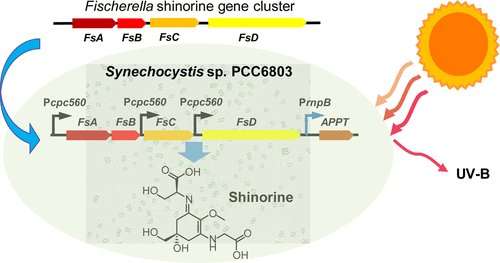Getting ready for the summer sun with 'green' sunscreens

Although it's been a tough winter for many people in the U.S., summer is coming. And that means backyard barbeques, fun on the beach and, of course, slathering on sunscreen. But one particular environmentally friendly sunscreen ingredient has been difficult to obtain—that ingredient, shinorine, could only be harvested from nature. Scientists now report in ACS Synthetic Biology the laboratory production of that compound.
Sunscreen is key to protecting the skin from carcinogenic UV radiation. However, some synthetic sunscreen components can accumulate in aquatic environments and potentially cause harm by acting as hormone disruptors. One alternative to these ingredients is the biodegradable sunscreen compound shinorine, a UV-absorbing substance produced naturally by cyanobacteria and marine algae. The shinorine currently found in commercially available sunscreens comes from red algae gathered from the sea, but the yield can vary seasonally and geographically, limiting supply. So, Yousong Ding and colleagues sought to develop a more reliable source of shinorine by bringing production out of the wild and into the laboratory.
The team selected a strain of freshwater cyanobacteria, Synechocystis, as a host cell for shinorine expression because it grows quickly, and it is easy for scientists to change its genes. Next, they mined the cluster of genes responsible for the synthesis of shinorine from a native producer, the filamentous cyanobacterium Fischerella. The researchers then inserted these genes into Synethcocystis. At first, the production was dismal, three times lower than Fischerella production. But adding extra promoters to the gene cluster increased production ten-fold. Finally, the team exposed control cells and those expressing shinorine to UV radiation. No growth differences were observed with UV-A light. But control cells experienced an obvious decline in population from UV-B exposure. The researchers say that in the other cells, shinorine acted as sunscreen against UV-B light, which helped the cells live and grow better.
More information: Guang Yang et al. Photosynthetic Production of Sunscreen Shinorine Using an Engineered Cyanobacterium, ACS Synthetic Biology (2018). DOI: 10.1021/acssynbio.7b00397
Abstract
Mycosporine-like amino acids (MAAs) are secondary metabolites of a variety of marine organisms including cyanobacteria and macroalgae. These compounds have strong ultraviolet (UV) absorption maxima between 310 and 362 nm and are biological sunscreens for counteracting the damaging effects of UV radiation in nature. The common MAA shinorine has been used as one key active ingredient of environmentally friendly sunscreen creams. Commercially used shinorine is isolated from one red algae that is generally harvested from the wild. Here, we describe the use of Synechocystis sp. PCC6803 as a host for the heterologous production of shinorine. We mined a shinorine gene cluster from the filamentous cyanobacterium Fischerella sp. PCC9339. When expressing the cluster in Synechocystis sp. PCC6803, we observed the production of shinorine using LC–MS analysis, but its productivity was three times lower than the native producer. Integrated transcriptional and metabolic profiling identified rate-limiting steps in the heterologous production of shinorine. The use of multiple promoters led to a 10-fold increase of its yield to 2.37 ± 0.21 mg/g dry biomass weight, comparable to commercially used shinorine producer. The UV protection of shinorine was further confirmed using the engineered Synechocystis sp. PCC6803. This work was the first time to demonstrate the photosynthetic overproduction of MAA. The results suggest that Synechocystis sp. PCC6803 can have broad applications as the synthetic biology chassis to produce other cyanobacterial natural products, expediting the translation of genomes into chemicals.
Journal information: ACS Synthetic Biology
Provided by American Chemical Society




















